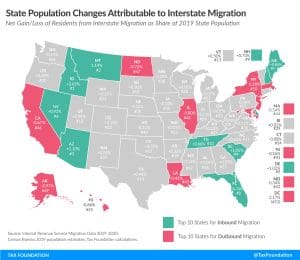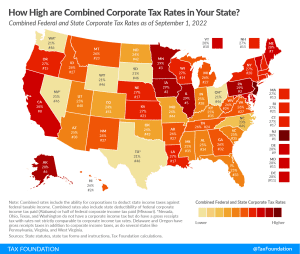Cigarette Taxes and Cigarette Smuggling by State, 2020
People respond to incentives. As tax rates increase or products are banned from sale, consumers and producers search for ways around these penalties and restrictions.
19 min readHow does New York’s tax code compare? New York has a graduated state individual income tax, with rates ranging from 4.00 percent to 10.90 percent. There are also jurisdictions that collect local income taxes. New York has a graduated corporate income tax, with rates ranging from 6.5 percent to 7.25 percent. New York also has a 4.00 percent state sales tax rate and an average combined state and local sales tax rate of 8.53 percent. New York has a 1.54 percent effective property tax rate on owner-occupied housing value.
New York has an estate tax. New York has a 25.68 cents per gallon gas tax rate and a $5.35 cigarette excise tax rate. The State of New York collects $10,380 in state and local tax collections per capita. New York has $19,407 in state and local debt per capita and has a 92 percent funded ratio of public pension plans. Overall, New York’s tax system ranks 49th on our 2024 State Business Tax Climate Index.
Each state’s tax code is a multifaceted system with many moving parts, and New York is no exception. The first step towards understanding New York’s tax code is knowing the basics. How does New York collect tax revenue? Click the tabs below to learn more! You can also explore our state tax maps, which are compiled from our annual publication, Facts & Figures 2024: How Does Your State Compare?

People respond to incentives. As tax rates increase or products are banned from sale, consumers and producers search for ways around these penalties and restrictions.
19 min read
In times of high inflation, states should consider adopting permanent full expensing because it boosts long-run productivity, economic output, and wages.
7 min read
All corporate income taxes fall on capital investment, but the structure should not make matters worse, and policymakers should take care not to distort investment decisions through the use of targeted incentives for select firms or activities instead of a lower rate for all businesses.
2 min read
Remote and flexible work opportunities are here to stay, whether states like it or not. With enhanced opportunities to take their job with them wherever they please, more workers can factor tax burdens into their decision of where to live.
15 min read
Recreational marijuana taxation is one of the hottest policy issues in the U.S. Currently, 19 states have implemented legislation to legalize and tax recreational marijuana sales.
5 min read
While there are many ways to show how much is collected in taxes by state governments, our Index is designed to show how well states structure their tax systems by focusing on the how more than the how much in recognition of the fact that there are better and worse ways to raise revenue.
129 min read
IRS and Census data show that people and businesses favor states with low and structurally sound tax systems, which can impact the state’s economic growth and governmental coffers.
12 min read
When NFL star wide receiver Tyreek Hill weighed offers from the New York Jets and the Miami Dolphins, no doubt there was a lot on his mind. But one consideration towered over the rest, at least according to Hill himself: signing with the Jets “was very close to happening,” but “those state taxes man. I had to make a grown-up decision.”
7 min read
When examining tax burdens on businesses, it is important to consider both federal and state corporate taxes. Corporate taxes are one of the most economically damaging ways to raise revenue and are a promising area of reform for states to increase competitiveness and promote economic growth, benefiting both companies and workers.
2 min read
Property taxes are the primary tool for financing local government and generating state-level revenue in some states as well.
5 min read